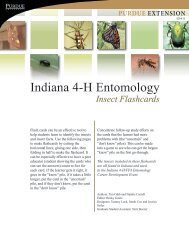Internal Insect Systems - Purdue Extension Entomology
Internal Insect Systems - Purdue Extension Entomology
Internal Insect Systems - Purdue Extension Entomology
Create successful ePaper yourself
Turn your PDF publications into a flip-book with our unique Google optimized e-Paper software.
What’s under the hood????
<strong>Internal</strong> <strong>Insect</strong> <strong>Systems</strong><br />
1. Flight- Musculature of wing movement<br />
2. Digestive- Consumption and processing of<br />
food<br />
3. Circulatory - movement of body fluids.<br />
4. Respiratory - breathing<br />
5. Nervous – enervation of muscles, and<br />
production of neurohoromones<br />
6. Reproductive
Flight System<br />
• Direct/Indirect Flight Muscles<br />
– Refers to muscle attachments relative to wing<br />
– Indirect flight in more advanced groups<br />
• Synchronous and Asynchronous muscles<br />
– Refers muscle contraction relative to<br />
innervation<br />
– Asynchronous contraction allows more rapid<br />
contraction and higher wing beats present in<br />
more advanced groups of insects
Direct flight muscles<br />
• Muscles are directly<br />
articulated to the<br />
wings<br />
• Found in more<br />
primitive orders<br />
– Paleoptera<br />
• Odonata<br />
• Ephemeroptera<br />
- and Blattodea<br />
Illustration Source: Hooper Virtual Paleontological Museum
Indirect flight muscles<br />
Illustration Source: Hooper<br />
Virtual Paleontological Museum<br />
• Muscles are NOT directly<br />
articulated to the wing<br />
• Contraction of longitudinal<br />
and dorsoventral muscles<br />
alternately contract to<br />
depress and relax the<br />
thoracic tergum.<br />
• Flight is powered by force of<br />
muscle contraction and<br />
tergum distortion.<br />
• Direct muscles attached to<br />
wing serve as minor<br />
adjustors<br />
• Neopterous Orders Only
<strong>Internal</strong> <strong>Insect</strong> <strong>Systems</strong><br />
head<br />
thorax<br />
abdomen<br />
circulatory<br />
system<br />
brain<br />
digestive<br />
tract<br />
nervous<br />
system<br />
(after John Meyer NC-State)
<strong>Insect</strong> Digestive System<br />
Generalized Diagram (typical of grasshopper)
Functional Regions of <strong>Insect</strong><br />
Digestive System<br />
• Foregut- Ingestion, Storage, grinding and<br />
transport of food to midgut<br />
• Midgut- Biochemical breakdown<br />
(digestion via secretion of enzymes) and<br />
nutrient absorption<br />
• Hindgut- Absorption of water, salts and<br />
other important minerals, elimination of<br />
feces through anus
Key Parts of Foregut<br />
• Mouth -ingestion<br />
• Oesophagous –tube<br />
• Salivary glands<br />
–digestive enzymes<br />
• Crop- holding<br />
• Proventriculus -<br />
grinding
Gastric ceacae<br />
Key Parts of Midgut<br />
ventriculus<br />
Peritrophic membrane<br />
• Ventriculus - lines the<br />
food bolus with a fine<br />
mesh made of<br />
chitin/carbohydrate/prote<br />
in mesh called the<br />
peritrophic membrane<br />
• Gastric ceacae are<br />
where nutrients are<br />
absorbed. Ceacal<br />
structure varies across<br />
orders
Key Parts of Hindgut<br />
Malpighian tubules<br />
• Malpighian tubules,<br />
like kidneys, filter<br />
waste out of insect<br />
blood (haemolymph),<br />
releasing urine into<br />
hindgut<br />
• Rectal pads resorb<br />
water and minerals<br />
into haemolymph
<strong>Insect</strong> Digestive System<br />
Caterpillar Digestive System<br />
(chewing insect)<br />
Milkweed Bug Digestive System<br />
(sucking insect)
<strong>Insect</strong> Circulatory System<br />
• Open circulatory system<br />
• Dorsal vessel supported by alary muscles<br />
that pump blood to head<br />
• Paired Ostioles in each segment are one<br />
way valves that suck blood into dorsal<br />
vessel<br />
• No hemoglobin in blood. Oxygen is<br />
delivered by respiratory system.
<strong>Insect</strong> Circulatory System<br />
Animation<br />
http://www.cals.ncsu.edu/course/ent425/tutorial/circulatory.html<br />
Click on the peristaltic contractions link to see pattern<br />
of insect blood movement
<strong>Insect</strong> Respiratory System<br />
Spiracles, Tracheae, Tracheal Trunks & Air Sacs, Tracheoles
<strong>Insect</strong> Respiration<br />
Spiracle<br />
Tracheae<br />
Tracheoles
Key Parts of Respiratory System<br />
• Spiracles –breathing holes<br />
• Tracheal tubes- coiled vacuum like hoses<br />
re-enforced with chitin strands called<br />
taenidia<br />
• Tracheoles – fine tubes with thin<br />
membranes that foster gas exchange<br />
• Oxygen in , Carbon Dioxide out<br />
Tutorial<br />
http://www.cals.ncsu.edu/course/ent425/tutorial/respire.html
<strong>Insect</strong> Nervous System
Key Points for Nervous System<br />
• 1 central signal processing unit (ganglion) per<br />
segment.<br />
• Brain is a super ganglion with many ganglia<br />
• Brain and ganglia secrete and moderate<br />
production of neurohormones involved in critical<br />
processes such as moulting and reproduction<br />
• Ventral nerve chord<br />
• Nerves and neurohormone activities are targets<br />
of many insecticides
<strong>Insect</strong> Nervous<br />
System<br />
<strong>Insect</strong> Brain
<strong>Insect</strong> Nervous System Tutorial<br />
http://www.cals.ncsu.edu/course/ent425/tutorial/nerves.html
Female Reproductive Organs<br />
ovaries<br />
spermatheca<br />
accessory glands<br />
bursa copulatrix<br />
http://www.cals.ncsu.edu/course/ent425/library/tutorials/internal_anatomy/female.html
Male Reproductive Organs<br />
testes<br />
accessory glands<br />
seminal vessicals<br />
aedegus (copulatory organ)<br />
http://www.cals.ncsu.edu/course/ent425/library/tutorials/internal_anatomy/male.html
Novel Aspects of <strong>Insect</strong><br />
Reproduction<br />
• Sperm is encased in protein like sacks<br />
(spermatophores) that protect sperm cells during<br />
delivery to the female<br />
• Females posses a specialized organ to hold<br />
sperm, and allow for selective fertilization of<br />
eggs.<br />
• <strong>Insect</strong>s with haplodiploid chromosome systems<br />
can determine sex of offspring (only fertilized<br />
eggs become females)<br />
• Parthenogenesis- reproduction without mating is<br />
common in many groups
<strong>Insect</strong> Reproductive System<br />
Female<br />
Male

















